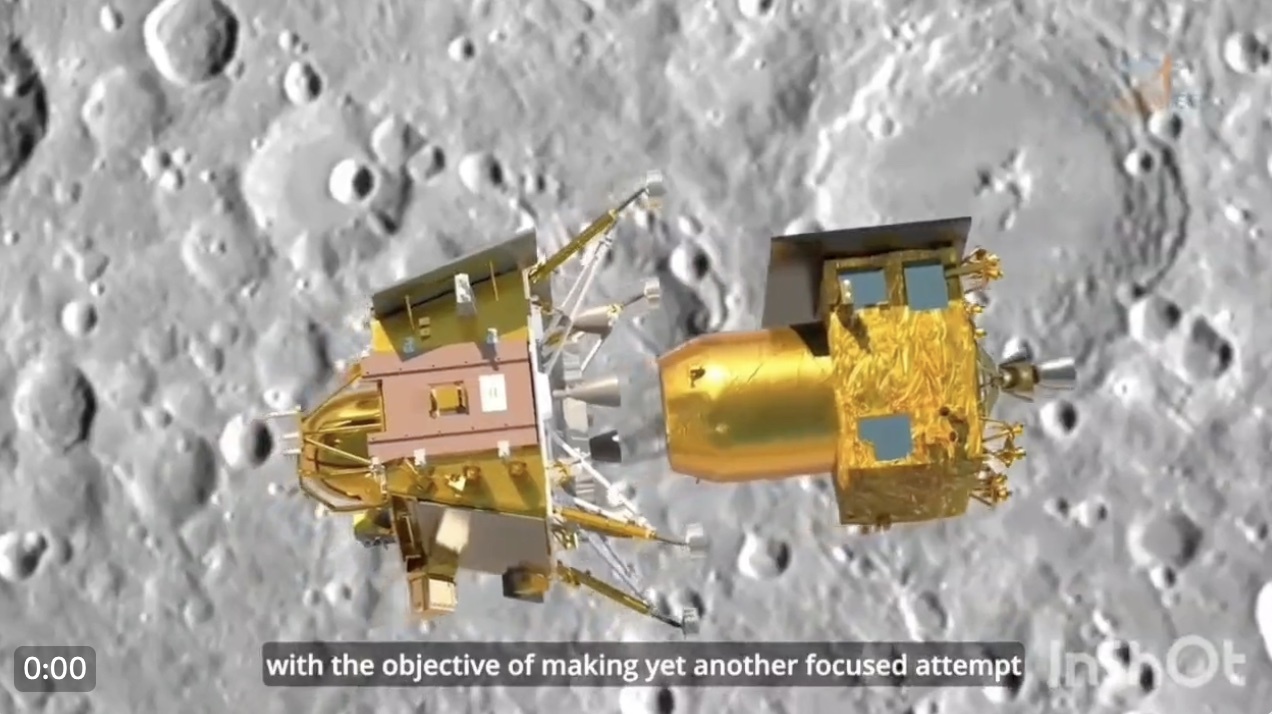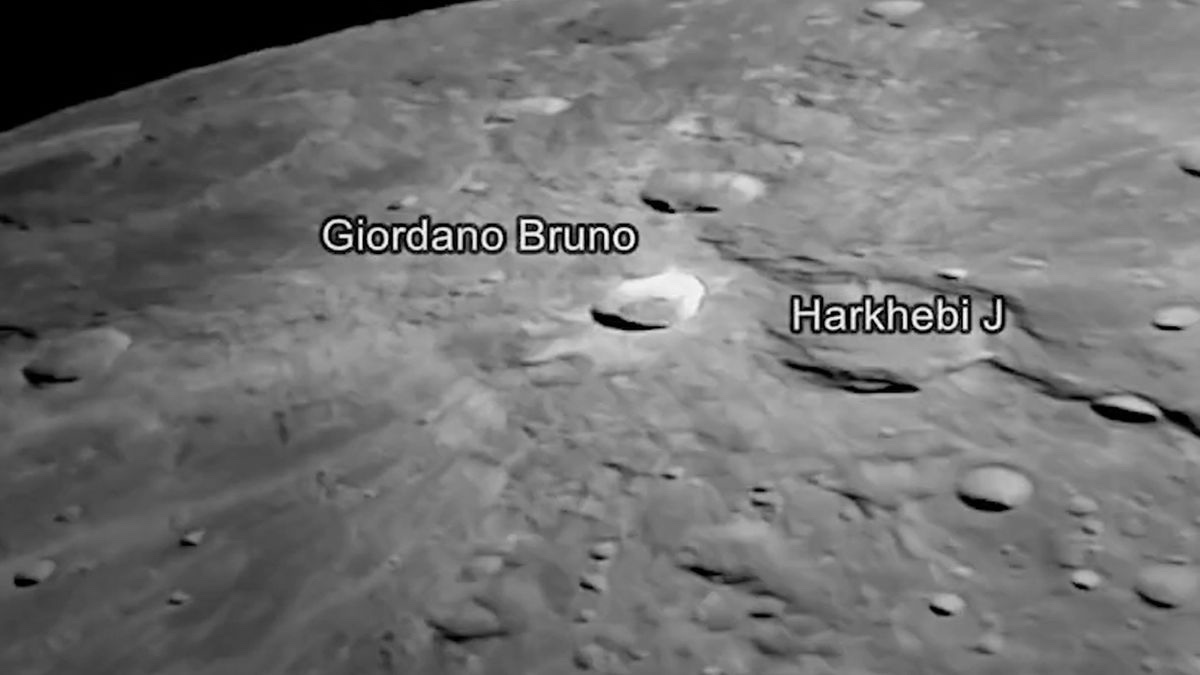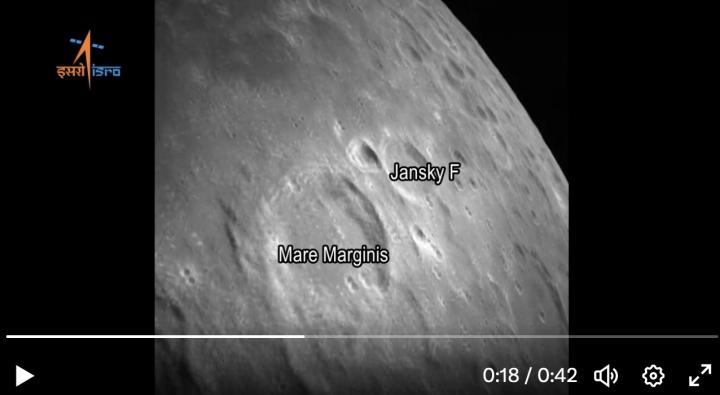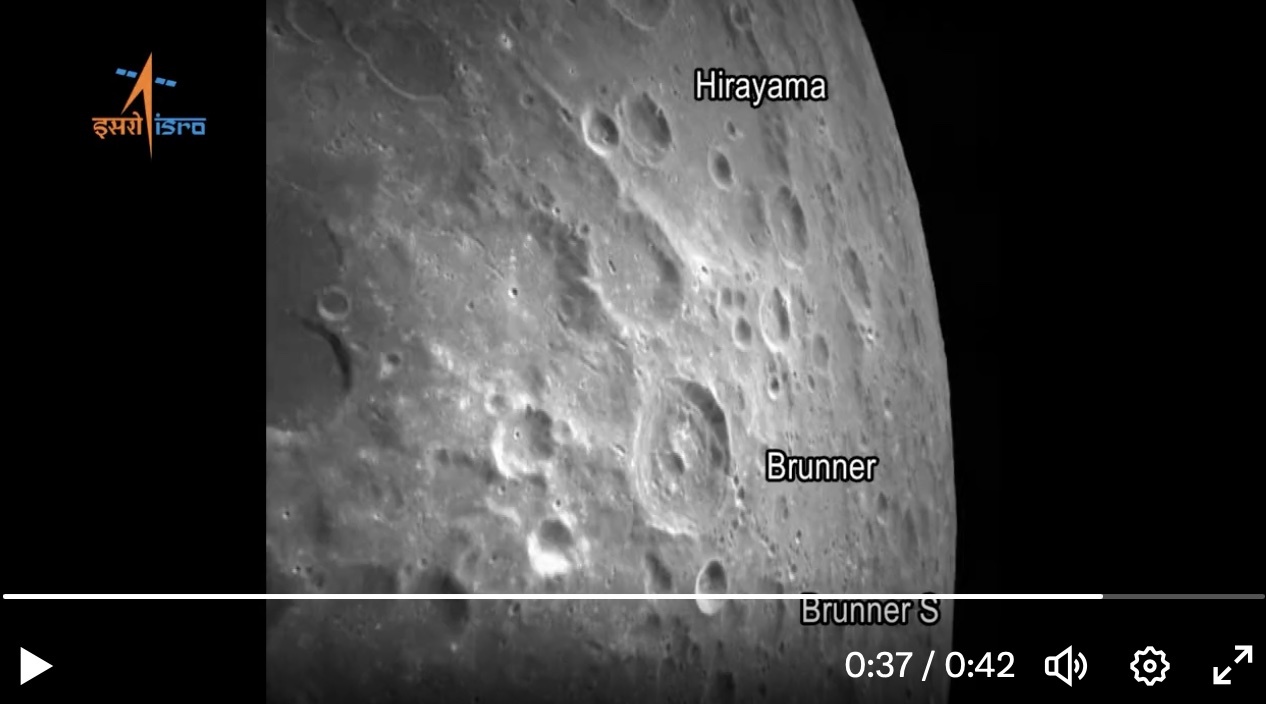8.08.2023
Chandrayaan-3: Historic India Moon mission sends new photos of lunar surface

A series of images sent by Chandrayaan-3 show the craters on the lunar surface getting larger and larger as the spacecraft gets closer
India's space agency has released the first images of the Moon taken by the Chandrayaan-3 spacecraft, which entered lunar orbit on Saturday.
The images show craters on lunar surface getting larger and larger as the spacecraft draws closer.
Chandrayaan-3's lander and rover are due to reach the surface on 23 August.
If successful, India will be the first country to perform a controlled "soft landing" near the south pole.
It will also become only the fourth to achieve a soft landing on the Moon after the US, the former Soviet Union and China.
After the spacecraft orbited the Earth for about 10 days, it was sent into the translunar orbit last Tuesday and successfully injected into the lunar orbit on Saturday.
Indian Space Research Agency (Isro) said that all checks showed that Chandrayaan-3 was in good "health".
It has also pointed out that "this is the third time in succession that Isro has successfully injected a spacecraft into the lunar orbit".
Scientists say Chandrayaan-3, the third in India's programme of lunar exploration, is expected to build on the success of its earlier Moon missions.
It comes 13 years after the country's first Moon mission in 2008, which discovered the presence of water molecules on the parched lunar surface and established that the Moon has an atmosphere during daytime.
Chandrayaan-2 - which also comprised an orbiter, a lander and a rover - was launched in July 2019 but it was only partially successful. Its orbiter continues to circle and study the Moon even today, but the lander-rover failed to make a soft landing and crashed during touchdown.
Isro chief Sreedhara Panicker Somanath has said India's space agency had carefully studied the data from its crash and carried out simulation exercises to fix the glitches in Chandrayaan-3, which weighs 3,900kg and cost 6.1bn rupees ($75m; £58m).
The lander (called Vikram, after the founder of Isro) weighs about 1,500kg and carries within its belly the 26kg rover which is named Pragyaan, the Sanskrit word for wisdom.
Now that the craft has entered the Moon's orbit, scientists will begin reducing the rocket's speed gradually to bring it to a point which will allow a soft landing for Vikram.
"A series of manoeuvres have been planned to gradually reduce the spacecraft's orbit and position it over the lunar poles," says Isro.
"After some manoeuvres, the propulsion module will separate from the lander while in orbit. Then a series of complex braking manoeuvres will be executed to facilitate a soft landing in the South Pole region of the Moon on 23 August," it adds.
Once it lands, the six-wheeled rover will eject and roam around the rocks and craters on the Moon's surface, gathering crucial data and images to be sent back to Earth for analysis.
"The rover is carrying five instruments which will focus on finding out about the physical characteristics of the surface of the Moon, the atmosphere close to the surface and the tectonic activity to study what goes on below the surface. I'm hoping we'll find something new," Mr Somanath has said.
The south pole of the Moon is still largely unexplored - the surface area that remains in shadow there is much larger than that of the Moon's north pole, and scientists say it means there is a possibility of water in areas that are permanently shadowed.
Quelle:BBC
+++
Chandrayaan-3 successfully lowers lunar orbit. What's ahead for Moon soft landing
Chandrayaan-3 latest updates: The spacecraft successfully lowers lunar orbit, health normal, next operation on August 9, landing attempt on August 23.

The Moon, as viewed by Chandrayaan 3 spacecraft during Lunar Orbit Insertion (LOI), on Sunday. (ISRO/ANI)
Chandrayaan-3 spacecraft on Sunday inched closer to its soft landing on the moon as it successfully underwent a planned orbit reduction manoeuvre lowering its lunar orbit. The health of India's third lunar mission craft is normal, Indian Space Research Organisation (ISRO) said.
Chandrayaan-3 tracker: What is the spacecraft's current orbit?
"The retrofitting of engines brought it closer to the Moon's surface, now to 170 km x 4,313 km. The next operation to further reduce the orbit is scheduled for August 9, between 13:00 and 14:00 hours IST," the ISRO posted on social media platform X on Sunday.
The Chandrayaan-3 mission achieved a crucial milestone with the successful completion of the Lunar Orbit Insertion (LOI) on Saturday placing it in the moon orbit and leaving Earth's gravity.
This is the third time in succession that ISRO has successfully inserted its spacecraft into the lunar orbit, apart from doing so into the Martian orbit. Meanwhile, the space agency on Sunday put out the first images of the moon as captured by Chandrayaan-3, India's third lunar mission.
Chandrayaan-3 mission milestones: A timeline
July 6: ISRO announced the launch date for Mission Chandrayaan-3, set for July 14, from Sriharikota's second launch pad.
July 7: Successful completion of vehicle electrical tests.
July 11: A comprehensive 'Launch Rehearsal' spanning 24 hours concluded, simulating the entire launch process.
July 14: LVM3 M4 vehicle triumphantly launched Chandrayaan-3 into its designated orbit.
July 15: The first orbit-raising manoeuvre, Earthbound firing-1, was executed successfully at ISTRAC/ISRO, Bengaluru. The spacecraft reached a 41762 km x 173 km orbit.
July 17: Accomplishment of the second orbit-raising manoeuvre resulted in the Chandrayaan-3 spacecraft orbiting at 41603 km x 226 km.
July 22: Successful completion of the fourth orbit-raising manoeuvre, Earth-bound perigee firing, establishing the spacecraft in a 71351 km x 233 km orbit.
July 25: Implementation of another successful orbit-raising manoeuvre.
August 1: Chandrayaan-3 achieved a significant milestone by being inserted into the translunar orbit, reaching an orbit of 288 km x 369328 km.
August 5: Chandrayaan-3 accomplished a major triumph by achieving successful insertion into the lunar orbit, attaining the intended orbit of 164 km x 18074 km.
August 6: The spacecraft orbit is lowered to 170 km x 4,313 km around the moon
What's ahead in Chandrayaan-3 mission?
As the mission advances, a sequence of manoeuvres is planned to gradually position Chandrayaan-3 in a 100km lunar orbit and align it with the lunar poles.
In the next ten days, a precise landing site near the moon's south pole will be determined. Subsequently, the propulsion module will detach from the lander while in orbit. Following this, the lander will descend from orbit and make a soft landing attempt.
When is the Chandrayaan-3 landing date?
Afterwards, a series of intricate braking manoeuvres will be executed to facilitate a soft landing in the Moon's South Polar region on August 23, at 5:47pm.
ISRO is closely monitoring the lunar landing schedule, considering factors like the moon's sunrise. If needed, the landing may be rescheduled for September. With each milestone achieved, India's Chandrayaan-3 mission edges closer to an unprecedented lunar landing accomplishment.
Quelle: Hindustan Times
----
Update: 10.08.2023
.
Chandrayaan-3 highlights: Moon now less than 1,500km away, ISRO performs 3rd lunar-bound
manoeuvre
Chandrayaan-3 highlights: ISRO's Lunar orbit manoeuvre placed the spacecraft in 174 km x 1437 km orbit, taking it closer to the moon.

Chandrayaan-3 latest Updates(ISRO)
Chandrayaan-3 Mission highlights: The Indian Space Research Organisation (ISRO) performed the next Lunar bound orbit manoeuvre today, placing the spacecraft in 174 km x 1437 km orbit.
The previous orbit reduction move for Chandrayaan 3 spacecraft was performed successfully on Sunday as planned, using the onboard propulsion system. The orbit achieved is 170 km x 4,313 km.
Chadrayaan-3 Updates: Next lunar orbit reduction manoeuvre on August 14
The Chandrayaan-3 next operation to further reduce the orbit is scheduled for August 14, 2023, between 11:30 and 12:30 Hrs. IST.
Quelle: Hindustan Times
----
Update: 15.08.2023
.
Chandrayaan-3 gets closer to 100km circular orbit; 1 move away before Vikram separation
Post its launch on July 14, Chandrayaan-3 entered into the lunar orbit on August 5, following which two orbit reduction maneuvers were carried out on August 6 and 9.
"Orbit circularisation phase commences. Precise maneuver performed today has achieved a near-circular orbit of 150 km x 177 km," ISRO said in a tweet.
The next operation is planned for August 16, around 8:30 am, it said. As the mission progresses, a series of maneuvers is being conducted by ISRO to gradually reduce Chandrayaan-3's orbit and position it over the lunar poles.
According to ISRO sources, one more maneuver will be performed on the spacecraft on August 16 to reach 100 km orbit, following which the landing module, comprising the lander and rover will break away from the propulsion module. After this, the lander is expected to undergo a 'deboost' (the process of slowing down) and make a soft landing on the south polar region of the Moon on August 23.
Last week, ISRO Chairman S Somnath had said the most critical part of the landing is the process of bringing the velocity of the lander from 30 km height to the final landing, and that the ability to transfer the spacecraft from horizontal to vertical direction is the 'trick we have to play' here. He said, "the velocity at the starting of the landing process is almost 1.68 km per second, but thisspeed is horizontal to the surface of the moon. The Chandrayaan 3 here is tilted almost 90 degrees, it has to become vertical. So this whole process of turning from horizontal to vertical is a very interesting calculation mathematically. We have done a lot of simulations. It is here where we had the problem last time (Chandrayaan 2)." Further, it has to be ensured that fuel consumption is less, the distance calculation is correct, and all the algorithms are working properly.
"Extensive simulations have gone, guidance design have been changed, and a lot of algorithms have been put in place to make sure that in all these phases required dispersions are handled....to attempt to make a proper landing," he said.
The mission objectives of Chandrayaan-3 are to demonstrate safe and soft landing on the lunar surface, to demonstrate rover roving on the Moon, and to conduct in-situ scientific experiments.
The lander will have the capability to soft land at a specified lunar site and deploy the rover that will carry out in-situ chemical analysis of the Moon's surface during the course of its mobility.
The lander and the rover have scientific payloads to carry out experiments on the lunar surface.
Quelle: BQ Prime
----
Update: 19.08.2023
.
Chandrayaan-3: What Happens To The Propulsion Module After Separation
Chandrayaan-3 : The propulsion module is the primary workhorse of the spacecraft, responsible for carrying the lander module to a safe orbit around the Moon.
New Delhi:
Chandrayaan-3 spacecraft's lander Vikram today successfully separated from its propulsion module and continued its journey towards the Moon where it is expected to make a soft landing on August 23.
"'Thanks for the ride, mate!' said the Lander Module (LM). LM is successfully separated from the Propulsion Module (PM). LM is set to descend to a slightly lower orbit upon a deboosting planned for tomorrow around 1600 Hrs, IST," ISRO wrote on X, formerly known as Twitter.

What happens to the propulsion module?
The propulsion module is the primary workhorse of the spacecraft, responsible for carrying the lander module to a safe orbit around the Moon.
According to ISRO, the propulsion module will continue to orbit Earth for months or even years, conducting spectroscopic studies of its atmosphere and measuring the polarisation of light from Earth's clouds.
"LM is successfully separated from the Propulsion Module (PM). LM is set to descend to a slightly lower orbit upon a deboosting planned for tomorrow," ISRO wrote on X, formerly known as Twitter.
Chandrayaan-3 was launched into space by the LVM3 rocket from the Satish Dhawan Space Centre in Sriharikota on July 14.
The propulsion module carried the lander Vikram and the rover Pragyaan configuration to a 100-kilometre lunar orbit. The lander then separated from the propulsion module and will now attempt a soft landing on the lunar surface.
The propulsion module carries the SHAPE payload, which will analyse the spectral and polarimetric properties of light from Earth.
"The SHAPE payload onboard would perform spectroscopic study of the Earth's atmosphere and measure the variations in polarisation from the clouds on Earth to accumulate signatures of exoplanets that would qualify for our habitability!" ISRO wrote on X.
Chandrayaan-3, a follow-up mission to Chandrayaan-2, will attempt to land a spacecraft on the moon and deploy the rover to explore the lunar surface. The rover will collect data on the composition and geology of the moon, which will help scientists learn more about the history and evolution of our nearest celestial neighbor.
In addition to its primary objective of landing a spacecraft on the Moon, Chandrayaan-3 will also conduct in-situ scientific experiments to study the lunar environment, such as its history, geology, and potential for resources.
Chandrayaan-3 is carrying six scientific payloads to study the lunar soil, capture photographs of Earth from lunar orbit, and perform other experiments.
During its 14-day mission (one lunar day) on the lunar surface, Chandrayaan-3 will conduct a series of groundbreaking experiments using its payloads RAMBHA and ILSA. These experiments will study the lunar atmosphere and subsurface to better understand its mineral composition.
The rover Pragyaan will use its laser beams to melt a piece of the lunar surface, called regolith, and analsze the gases emitted in the process. Through this mission, India will not only access a wealth of knowledge about the lunar surface but also its potential for human habitation in the future.
Post a comment The spacecraft is expected to land on the lunar surface at 5:47 pm on August 23.
Quelle: NDTV
----
Update: 20.08.2023
.
Chandrayaan-3 is on its journey to the moon.

Chandrayaan-3 is a follow-on mission to Chandrayaan-2 to demonstrate end-to-end capability in safe landing and roving on the lunar surface. It consists of Lander and Rover configuration. It will be launched by LVM3 from SDSC SHAR, Sriharikota. The propulsion module will carry the lander and rover configuration till 100 km lunar orbit. The propulsion module has Spectro-polarimetry of Habitable Planet Earth (SHAPE) payload to study the spectral and Polari metric measurements of Earth from the lunar orbit.
Lander payloads: Chandra’s Surface Thermophysical Experiment (ChaSTE) to measure the thermal conductivity and temperature; Instrument for Lunar Seismic Activity (ILSA) for measuring the seismicity around the landing site; Langmuir Probe (LP) to estimate the plasma density and its variations. A passive Laser Retroreflector Array from NASA is accommodated for lunar laser ranging studies.
Rover payloads: Alpha Particle X-ray Spectrometer (APXS) and Laser Induced Breakdown Spectroscope (LIBS) for deriving the elemental composition in the vicinity of landing site.
+++
The Lander Module is in 113 km x 157 km orbit around the moon. Second de-boosting is planned for August 20, 2023
Quelle: ISRO
+++
India's Chandrayaan-3 snaps close-up photos of moon ahead of landing try











